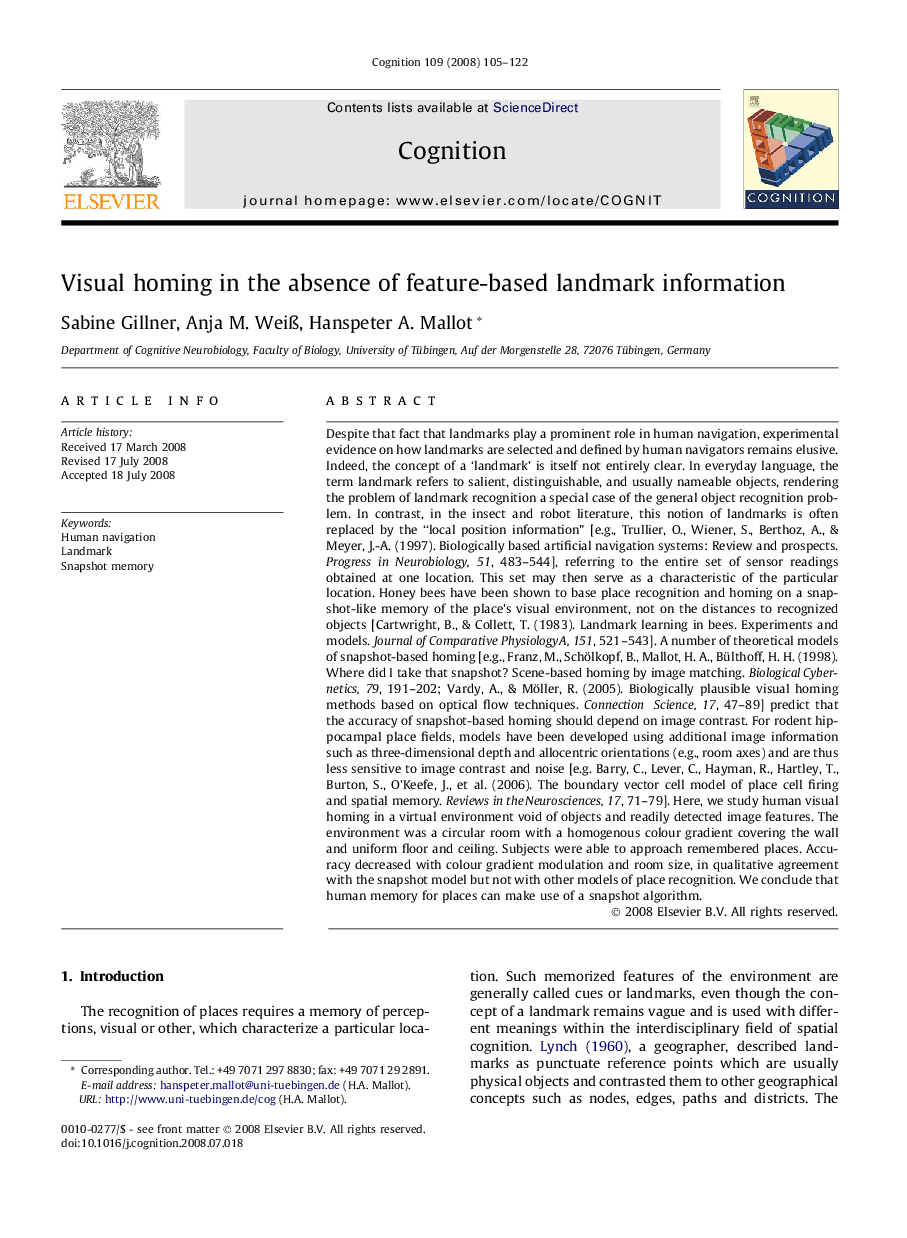| کد مقاله | کد نشریه | سال انتشار | مقاله انگلیسی | نسخه تمام متن |
|---|---|---|---|---|
| 10458033 | 921965 | 2008 | 18 صفحه PDF | دانلود رایگان |
عنوان انگلیسی مقاله ISI
Visual homing in the absence of feature-based landmark information
دانلود مقاله + سفارش ترجمه
دانلود مقاله ISI انگلیسی
رایگان برای ایرانیان
موضوعات مرتبط
علوم زیستی و بیوفناوری
علم عصب شناسی
علوم اعصاب شناختی
پیش نمایش صفحه اول مقاله

چکیده انگلیسی
Despite that fact that landmarks play a prominent role in human navigation, experimental evidence on how landmarks are selected and defined by human navigators remains elusive. Indeed, the concept of a 'landmark' is itself not entirely clear. In everyday language, the term landmark refers to salient, distinguishable, and usually nameable objects, rendering the problem of landmark recognition a special case of the general object recognition problem. In contrast, in the insect and robot literature, this notion of landmarks is often replaced by the “local position information” [e.g., Trullier, O., Wiener, S., Berthoz, A., & Meyer, J.-A. (1997). Biologically based artificial navigation systems: Review and prospects. Progress in Neurobiology, 51, 483-544], referring to the entire set of sensor readings obtained at one location. This set may then serve as a characteristic of the particular location. Honey bees have been shown to base place recognition and homing on a snapshot-like memory of the place's visual environment, not on the distances to recognized objects [Cartwright, B., & Collett, T. (1983). Landmark learning in bees. Experiments and models. Journal of Comparative Physiology A, 151, 521-543]. A number of theoretical models of snapshot-based homing [e.g., Franz, M., Schölkopf, B., Mallot, H. A., Bülthoff, H. H. (1998). Where did I take that snapshot? Scene-based homing by image matching. Biological Cybernetics, 79, 191-202; Vardy, A., & Möller, R. (2005). Biologically plausible visual homing methods based on optical flow techniques. Connection Science, 17, 47-89] predict that the accuracy of snapshot-based homing should depend on image contrast. For rodent hippocampal place fields, models have been developed using additional image information such as three-dimensional depth and allocentric orientations (e.g., room axes) and are thus less sensitive to image contrast and noise [e.g. Barry, C., Lever, C., Hayman, R., Hartley, T., Burton, S., O'Keefe, J., et al. (2006). The boundary vector cell model of place cell firing and spatial memory. Reviews in the Neurosciences, 17, 71-79]. Here, we study human visual homing in a virtual environment void of objects and readily detected image features. The environment was a circular room with a homogenous colour gradient covering the wall and uniform floor and ceiling. Subjects were able to approach remembered places. Accuracy decreased with colour gradient modulation and room size, in qualitative agreement with the snapshot model but not with other models of place recognition. We conclude that human memory for places can make use of a snapshot algorithm.
ناشر
Database: Elsevier - ScienceDirect (ساینس دایرکت)
Journal: Cognition - Volume 109, Issue 1, October 2008, Pages 105-122
Journal: Cognition - Volume 109, Issue 1, October 2008, Pages 105-122
نویسندگان
Sabine Gillner, Anja M. WeiÃ, Hanspeter A. Mallot,